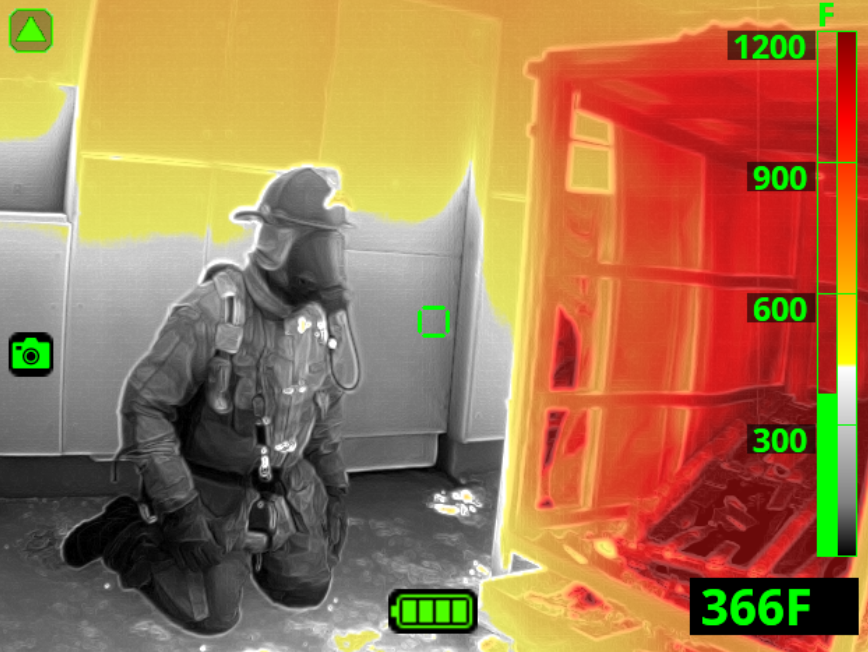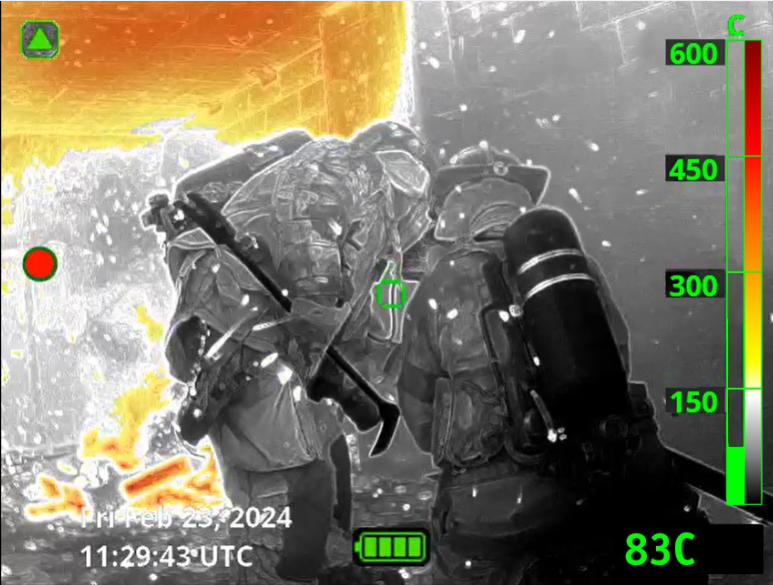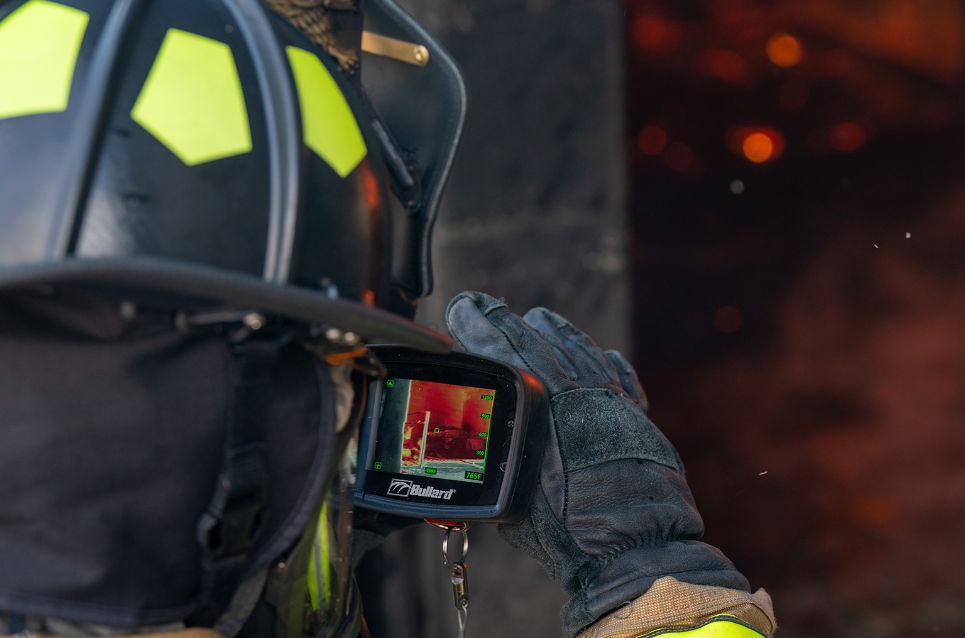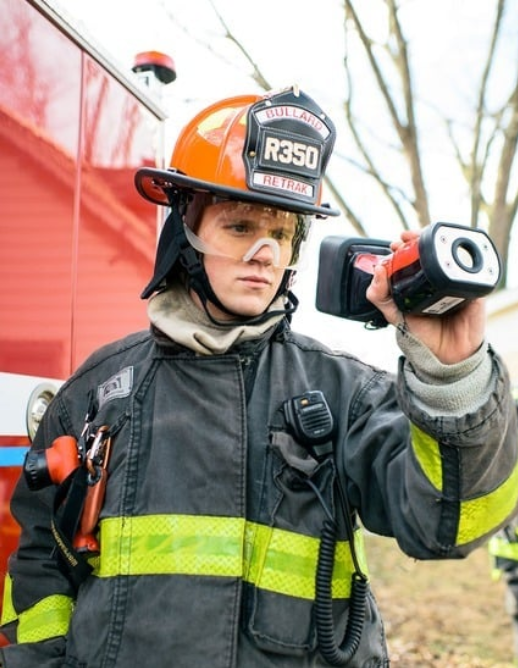Colorization in thermal imaging plays a vital role in firefighting, offering visual cues to identify high-temperature areas and improving situational awareness. However, differences in how and when colorization appears highlight critical considerations for firefighters. This article explores the benefits, challenges, and practical implications of colorization, offering insights into real-world firefighting needs.
How Colorization Works
Thermal imagers translate heat signatures into visible images. Grayscale imaging uses varying shades of gray to represent temperature changes, while colorization overlays colors like yellow, orange, and red to highlight higher heat zones.
The most common color palette for firefighting thermal imagers transitions as follows:
- Black to White: Cooler temperatures
- Yellow, Orange, Red: Higher heat levels when activated
While the palette is consistent across devices, the temperature thresholds—the points at which colors appear—vary. These thresholds significantly affect how firefighters interpret heat and make decisions.
Thresholds: When Colorization Begins
A key difference between thermal imagers is their temperature thresholds for colorization:
- Some imagers begin introducing yellow at lower thresholds (e.g., 300°F), providing earlier visual cues but potentially distracting from details.
- Others delay colorization until higher thresholds (e.g., 500°F), ensuring that colors highlight only the most critical heat zones.
The Case for 300F Colorization
Early colorization has advantages, particularly in situations where immediate recognition of rising heat is critical:
- Faster Color Response: Firefighters under stress may respond more quickly to color than to subtle grayscale variations. Early color provides immediate cues to rising temperatures.
- Safety Margins: Colorization at lower thresholds warns of increasing heat levels well before conditions approach critical gear limitations.
- Simplified Interpretation: Early colorization can provide more clarity on the scene, reducing cognitive load in high-pressure environments.
Firefighter Perspective:
“Seeing yellow and orange early in the scene means I know the environment is heating up. It gives me the time to act before things get dangerous.”
The Case for 500F+ Colorization
Higher heat colorization offers significant benefits, particularly in more complex or high-temperature environments:
- Minimized Visual Noise: Higher heat colorization helps ensure that colors appear only when temperatures reach critical levels, preventing colorization of minor heat differences from cluttering the image.
- Clarity in Grayscale: Grayscale imaging excels at showing victims and structural details, like shapes, pathways, and potential hazards. Introducing color only at higher temperatures helps ensure these details remain clear.
- Focused Highlights: Delayed thresholds prioritize critical areas, helping ensure color highlights only what truly matters in high-stakes scenarios.
Analogy:
Imagine navigating a smoky room. Early colorization is like a brightly lit room with flashing lights—it draws your eye to everything, making it hard to focus. Delayed colorization is like a focused spotlight, highlighting only the most critical areas so you can act decisively.
Transparent Overlays: Enhancing 500F+ Colorization
For imagers with higher heat colorization, features like transparent color balance clarity and heat detection. Transparent colorization offer:
- Selective Focus: Heat zones are highlighted without obscuring structural details or surrounding environments.
- Depth Perception: Transparent colors maintain scene depth, allowing firefighters to navigate effectively and judge distances.
- Reduced Eye Strain: Subtle, transparent color reduces fatigue during prolonged use, ensuring firefighters can better interpret scenes clearly over time.
Example Scenario:
In overhaul operations after a fire, transparent overlays help firefighters identify hotspots while still seeing surrounding debris and structural integrity. This balance prevents confusion and supports safer actions.
Checklist: Evaluating Colorization Features
When selecting a thermal imager, consider:
- What are your operating conditions? Smaller, contained spaces may benefit from early colorization, while larger or high-temperature areas require delayed thresholds.
- How is color applied? Transparent colorization allow for better detail and focus compared to solid color fills, which may obscure critical structures.
- When does colorization trigger? Match the threshold to your team’s priorities, balancing early heat warnings with scene clarity and details.
- What is your team’s response style? Test devices in realistic scenarios to understand how colorization affects decision-making under pressure.

Key Takeaways
- Colorization Supports Safety: The firefighting color palettes are a proven tool, but the effectiveness of colorization depends on thresholds and application methods.
- Balance is Key: Thresholds can improve responsiveness to high heat, while higher heat thresholds focus on critical heat zones and reduce distractions to focus on the details.
- Enhanced Clarity Matters: Features like transparent colors help ensure that colorization supports—not obscures—situational awareness.
- Test Before You Choose: Real-world testing helps ensure that thermal imagers align with your team’s unique operational needs.
By understanding how thresholds and application methods impact usability, departments can choose imagers that enhance firefighter safety and performance. Devices emphasizing delayed thresholds with features like transparent overlays often provide the clarity and focus necessary for high-pressure firefighting environments, without compromising safety.
See Bullard’s new X Factor 2.0 Image Enhancement with top of the line features here.



